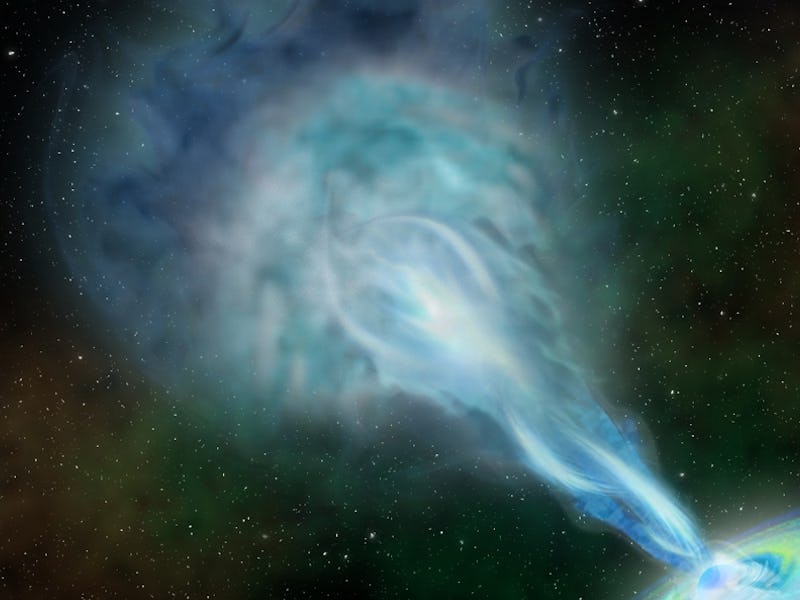Scientist Perplexed by His Discovery of Powerful Quasar From Early Universe

A newly discovered supermassive black hole, 13 billion light-years away from Earth, might eventually provide us with valuable information about the formation of the universe. In the meantime, it’s mostly just confusing Eduardo Bañados — the astronomer at the Observatories of the Carnegie Institution who found it. He describes his perplexing work this week in a pair of papers in Astrophysical Journal and Astrophysical Journal Letters.
“There are maybe 200 quasars that are at similar distances, but the peculiarity of this object is that it is extremely bright in radio waves,” Bañados told Inverse. A quasar is a galaxy with a supermassive black hole at its center that is constantly sucking up and spitting out stellar debris in the form of high-energy particles. Those particles, moving at close to the speed of light, are so hot that they usually emit a lot of light and radio-waves, appearing very bright from Earth. But this one was abnormally so.
“To be honest, at the beginning I did not believe that this was coming from the quasar,” says Bañados. “It was too strong. I had never seen such a strong radio-emitter when the universe was so young.” According to him, it’s the brightest quasar from the early universe by a factor of ten.
The quasar in this image, formed by two merging galaxies, is to the top left of the bright spiral galaxy. They're notoriously hard to image because they're so bright.
The fact that the radio waves emanating from this supermassive black hole — which forms a quasar labelled PSO J352.4034-15.3373 (P352-15) together with the galaxy pulled into its orbit — are unusually “loud” or “bright” means that the quasar itself was atypically dense and active for something that existed early in the formation of the universe. During the first billion years — the epoch of reionization — giant stars 30 to 300 times the size of our sun started to light up the vast darkness and, in the process, re-energized much of the inert hydrogen gas that was floating out from the big bang. P352-15 might have a comparable level of brightness to those stars, but it’s a lot larger than 300 times our sun.
“How can you form a supermassive black hole that is like a billion times the mass of the sun in less that a billion years?” Bañados keeps asking himself. “That’s really difficult.”
After finding the quasar, Bañados collaborated with Emmanuel Momjian of the National Radio Astronomy Observatory (NRAO) in Socorro, New Mexico in order to use the National Science Foundation’s Very Long Baseline Array (VLBA) to get a better view of whatever the hell P352-15 actually is (or was). The results of that work were published this week in the Astrophysical Journal and Astrophysical Journal Letters.
With some work, the VLBA produced a crisp radio-based visualization of the quasar, which has three main components with some distinct features of their own. The total distance across these three components is approximately 5,000 light-years. “Crisp,” here, is relative; your mileage may vary.
An image produced by the Very Long Baseline Array's collection of radio signals from the quasar P352–15, nearly 13 billion light-years from Earth.
He and his colleagues have two ideas about what could be going on with P352-15. In one interpretation, they’re seeing a bright core to the supermassive black hole at the center, with two other visible portions being the particle jets that it’s producing heading in opposite directions from each other. In another view, the black hole core is on one side and the two particle jets are moving in the same direction, concentrically.
The team is hoping it’s the latter case because it means that they could potentially observe this one-sided jet as it expands over several years. “This quasar may be the most distant object in which we could measure the speed of such a jet,” Momjian said in a prepared statement.
Despite the fact that quasars are by definition the combination of a supermassive black hole and the galaxy it’s consuming — and that black holes eject large, bright, radio-emitting jets of particles at the speed of light — only about 10 percent of quasars, this one included, are strong radio-emitters. At least right now, no one in the field knows why.
“This is a very active field of research, and we still don’t have a definite answer,” Bañados says. “Every time we find a system with quasars it’s a puzzle. We don’t know how to form them.”
The light from Quasar 3C 273 has taken about 2.5 billion years to reach Earth.
Going forward, the group hopes to use this new quasar to investigate “the role of radio-jets for the formation and growth of supermassive black holes” — which is how you would phrase to a grant-writing institution the unsettling fact that P352-15 totally fucks with how astrophysicists thought these celestial objects were formed.
“This jet has to be around 10,000 years [old],” Bañados says, “which sounds like a lot for us, but to form a supermassive black hole in less than 10,000 years is a big challenge for the theory of supermassive black holes.”
So, this new quasar might tell us a lot about how the young universe formed or what was going on in those first billion years after the big bang, but it might also just simply upset what we thought we knew.
“There are many things that we don’t know and sometimes people look at the scientists and are like, ‘Oh, They should know all the answers,’” Bañados says, “but that’s why we do research.”
“When we do that, most of the time, instead of finding answers, we find more questions.”